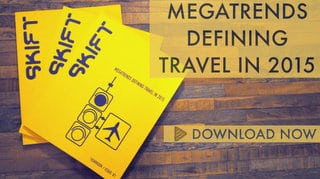Megatrends 2015: Travel Brands Look to Instagram for the Influencer Bump

Skift Take
Last month we launched our first ever magazine, Megatrends Defining Travel in 2015, where we identify the global trends in travel in 2015 and beyond, and focus on three emerging key themes: Mobile. Seamless. Experiential. Below is an extract from the one of the trends in the magazine.
Hotel brands and destination marketing organizations once saw travel blogs and their reach social networks — especially Twitter — as the best new source of un-filtered insight into their hotel or destination. That didn’t turn out to be the boon everyone hoped. From SEO setbacks to viral hashtags that never translated into boots on the round, the price of bringing a gaggle of bloggers and telling them what to write and how to market it has never quite achieve the return on investment hoped for.
So now many travel brands are embracing the promise of Instagram influencers and what they have to offer. More viral than bloggers and more immediate, this new breed of travel sharer promises to hit all the marks social media managers need: millennials, smartphones, in-market, visual, and, hopefully, viral.
They’re looking outside of travel, too, to Instagram personalities with followings that extend far beyond travel to family, food, sports, fashion, and design.
Yes, content is still king, but visuals reign.
When Instagram launched in 2010, it was popular with a creative community that was dominated by both professional and amateur photographers. The combination of having a highly visual community and simple mobile user experience of uploading and liking photos made it an app fit for the masses. In April 2012, it was acquired by Facebook and its user base grew exponentially. Simultaneously, early adopters like Cole Rise, Foster Huntington, and Pei Ketron gained notoriety and a larger following. In turn, agencies like Niche, and Stay & Wander, and Tinker popped up to represent these content producers.
How brands find and measure success is, as it was with blogging, still up in the air. We’ve seen brands such as British Airways or the Bermuda Tourism Authority mimic old methods of inviting a handful of Instagram influencers to an event or destination to snap pics, hashtag, and upload them to hopefully be liked and shared. Dubai’s iconic Burj al Arab invited Instagrammers for a weekend of high-end events and pampering in return for sharing it all with followers. These “Instameets” aim for maximum impact through a combination of volume and focus; if nothing else they’re fun for the attendees.
Lots of things are shared, but what that translates into is still to be determined.
On the flip side, some brands and destinations are keeping the Instagram focus, but ditching the influencer in favor of the mass of users who don’t need to be feted. Tourism Australia is the undisputed leader here, with a rate of sharing and liking of user images that is unparalleled by any other travel brand. Walt Disney World resorts mixes professional content with user uploads that encourages users to share as much as possible in hopes of getting additional followers themselves after a Disney “bump.”
One of the most successful travel brands on Instagram, though, is a U.S. government agency that spends very little money, but has excellent content to work with. The U.S. Department of the Interior is the voice of the U.S. National Park Service. Like Tourism Australia, it shares Instagram user images from across the country. The only influencer here is the visitor who’s captured a great shot of the Grand Canyon or a national seashore.
We want to thanks our magazine sponsors Virgin Atlantic, Amadeus and Egencia for making this possible.





